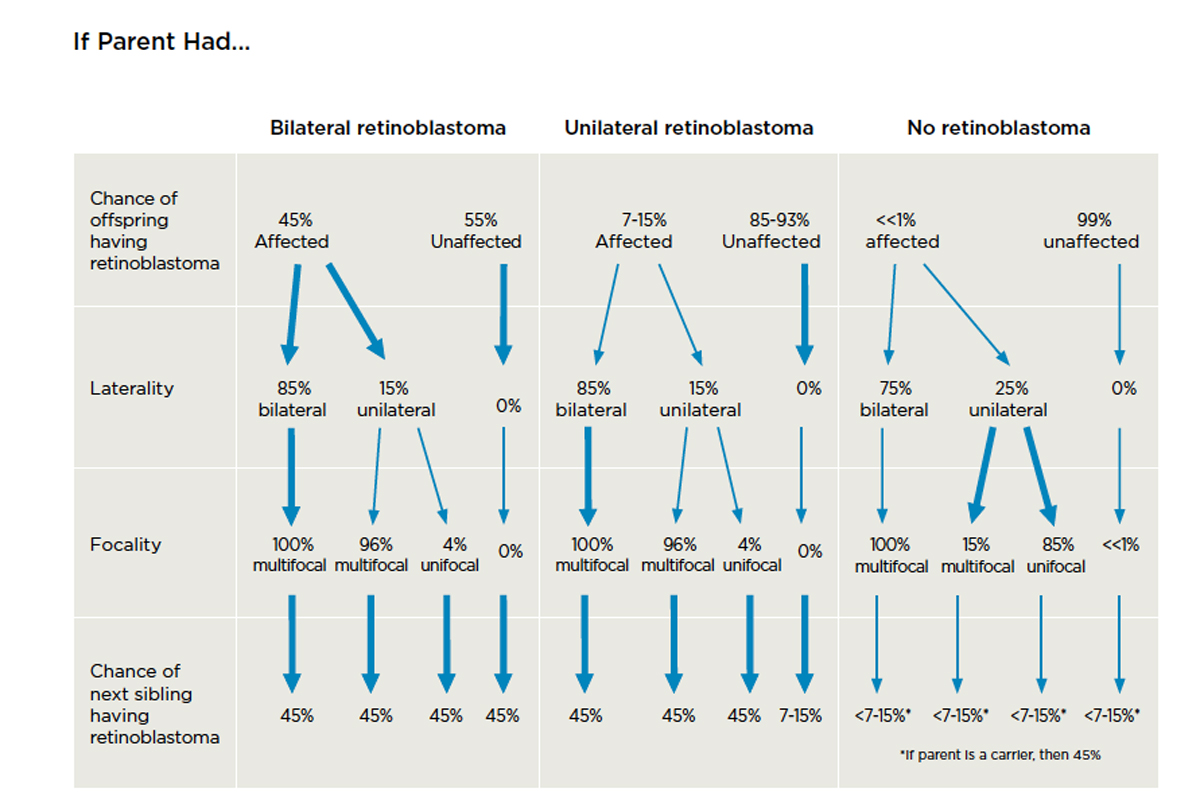This chart shows the likelihood that a parent will give retinoblastoma to a child.

Ninety percent of all children who develop retinoblastoma are the first person in their family to have eye cancer. It is hard to explain why a child with no family history develops retinoblastoma. Both parents of a child with retinoblastoma are encouraged to have a complete eye exam of their own.
When there is a family history of retinoblastoma, a child is most likely to develop the disease within 28 months of birth. Newborn babies should have a dilated eye exam by a pediatric ophthalmologist in the nursery.
The Genetics of Retinoblastoma
Retinoblastoma is caused by changes in a gene called RB1.
Genes are in nearly every cell of the human body. They are made up of DNA, which contains instructions to help the body work properly. Genes are part of structures called chromosomes. People have 23 pairs of chromosomes. One of each pair comes from the father and the other from the mother. All people have two copies of the RB1 gene, whether or not they have had retinoblastoma.
Mutations are changes in the sequence of the DNA that cause a gene not to work correctly. The job of the RB1 gene is to prevent retinoblastoma tumors from developing.When retinoblastoma develops, it is because both copies of the RB1 gene are not working correctly.
Can retinoblastoma be inherited?
About 40 percent of children with retinoblastoma have a hereditary form of the condition. Some children with hereditary retinoblastoma have inherited an RB1 mutation from a parent who had retinoblastoma as a child. More often, however, children with hereditary retinoblastoma do not have other family members with the disease. Instead, their condition was caused by a new mutation that occurred at random around the time of conception. In either case, an RB1 gene mutation is present in all of the cells in the child’s body, including the reproductive cells. Because the mutation is present in the reproductive cells, there is a 50 percent chance of passing the RB1 mutation to the next generation. This is called a germline mutation.
The other 60 percent of children with retinoblastoma have a sporadic form of the condition, which cannot be passed to the next generation. In this case, both RB1 mutations occurred only in the retinal cells.
How do I know if my child’s retinoblastoma is hereditary?
Children with a tumor in one eye, known as unilateral tumors, may have either hereditary or sporadic retinoblastoma. In families where there is no history of retinoblastoma, about15 percent of children with unilateral tumors have the hereditary form of the condition. About 85 percent have the sporadic form.
Children with tumors in both eyes, known as bilateral tumors, are presumed to have hereditary retinoblastoma. This is due to a germline RB1 mutation that can be passed to the next generation. About 90 percent of people who have a germline RB1 mutation will develop retinoblastoma tumors.
Rarely, a person can carry an RB1 germline mutation but not develop retinal tumors. For this reason, parents of a child with hereditary retinoblastomashould consider genetic testing. Parents may also consider having detailed eye exams of their own with an ophthalmologist, who will look for the presence of a cured or limited retinoblastoma, called a retinocytoma (also known as a retinoma).
Are people with retinoblastoma at higher risk for other cancers?
Having hereditary retinoblastoma increases the risk of developing other cancers outside of the eye. These cancers include pinealoma (a tumor in the pineal gland in the brain), a type of bone cancer called osteosarcoma, cancers of soft tissues (such as muscle), and a form of skin cancer called melanoma. Screening guidelines have recently been established to detect nonocular tumors at an early stage; however, this screening is not yet proven to reduce risk. Currently, people with hereditary retinoblastoma are recommended to have annual skin exams. In addition, limiting exposure to radiation, tobacco, and excessive sunlight may help reduce risk. There is also research being done into whether whole-body MRIs could benefit people with hereditary retinoblastoma.
Is genetic testing available?
Genetic testing can help determine if your child has hereditary or sporadic retinoblastoma. MSK’s genetic counselors are available to consult with families to discuss the benefits, limitations, and risks associated with testing. They can also help interpret the test results. Genetic testing can be done on the tumor (when available) and/or a blood sample from a person with retinoblastoma. If an RB1 gene mutation is found in the blood, it is possible to look for that mutation in other family members, who may need to be screened for development of the disease. Genetic testing can be performed before pregnancy if an RB1 gene mutation has been identified in the family. It may also be performed during pregnancy or after a child’s birth.



